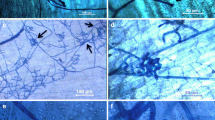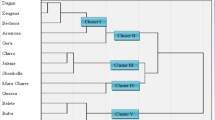Abstract
The disease inducing potential of tuberborne inoculum ofRhizoctonia solani AG-3 on potato was evaluated. Four cultivars of potato, with or without visible evidence of tuberborne inoculum and with or without formaldehyde treatment, were planted in the field. Total and US #1 yields were reduced by an average of 19.2% and 35.1% respectively on those plots from seed tubers with tuberborne inoculum and plots from seed tubers that received no formaldehyde treatment. Tuberborne inoculum delayed emergence by 23.9%, and large girdling lesions appeared on the subterranean stems of more than 90% of the plants produced from contaminated seed. A high incidence of aerial stem lesions and hymenial development also was associated with tuberborne inoculum. However, the number of stems per plant did not differ significantly among treatments. A two min dip in 1.85% aqueous solution of formaldehyde killed most if not all of the seedborne inoculum.
Compendio
Se evaluó el potencial del inóculo deRhizoctonia solani AG-3 presente en los tubérculos-semillas para inducir la rhizoctoniasis. Se sembraron en el campo cuatro variedades de papa, con o sin evidencia visible de inóculo presente en los tubérculos-semillas y con o sin tratamiento de formaldehido. Los rendimientos total y de US #1 se redujeron en promedio 19,2% y 35,1%, respectivamente, en los tratamientos con inóculo presente y sin tratamiento con formaldehido. El inóculo presente en los tubérculos-semillas retardó la emergencia de 23,9% de las plantas y dio origen a grandes lesiones circundantes en los tallos subterraneos de más de 90% de las plantas. Una alta incidencia de lesiones en los tallos aéreos y de desarrollo himenial estuvo también asociada con el inóculo presente en los tubérculos-semillas. Sin embargo, el número de tallos por planta no tuvo diferencias significativas entre los tratamientos. Una inmersión de dos minutos en una solución acuosa al 1,85% de formaldehido eliminó la mayor parte sino el total del inóculo presente en los tubérculos-semillas.
Similar content being viewed by others
Literature Cited
Abe, H. and K. Tsuboki. 1978. Anastomosis groups of isolates ofRhizoctonia solani Kuhn from potatoes. Bull. Hokkaido Prefect Agric Exp Stn 40:61–70.
Bandy, B.P., D.H. Zanzinger and S.M. Tavantzis. 1984. Isolation of anastomosis group 5 ofRhizoctonia solani from potato field soils in Maine. Phytopathology 74:1220–1224.
Bandy, B.P., S.S. Leach and S.M. Tavantzis. 1988. Anastomosis group 3 is the major cause of Rhizoctonia disease of potato in Maine. Plant Disease 72:596–598.
Banville, G.J. 1978. Studies on the rhizoctonia disease of potatoes. Amer Potato J 55:56.
Bolkan, H.A., H.T. Wenham and K.S. Milne. 1974. Effect of soil temperature on severity ofRhizoctonia solani infection on potato shoots. Plant Dis Reptr 58:646–649.
Carling, D.E. and R.H. Leiner. 1986. Isolation and characterization ofRhizoctonia solani and binucleateR. solani-like fungi from aerial stems and subterranean organs of potato plants. Phytopathology 76:725–729.
Carling, D.E., R.H. Leiner and K.M. Kebler. 1987. Characterization of a new anastomosis group (AG-9) ofRhizoctonia solani. Phytopathology 77:1609–1612.
Carling, D.E. and P.C. Westphale. 1988. Effect of seedborne inoculum ofRhizoctonia solani and formaldehyde on growth and yield of potato. Pathology, Kyoto, Japan. p. 194.
Chand, T. and C. Logan. 1983. Cultural and pathogenic variation in potato isolates ofRhizoctonia solani in Northern Ireland. Trans Br Mycol Soc 81:585–589.
Chang, Y.C. and C.C. Tu. 1980. Cultural and pathogenic variation in potato isolates ofRhizoctonia solani Kuhn in potatoes. (Abstr.) J Agric Res China 29:1.
Davis, J.R. 1978. The rhizoctonia disease of potato in Idaho. Amer Potato J 55:58–59.
Easton, G.D. 1978. The rhizoctonia disease of potatoes in Washington. Amer Potato J 55:57–58.
Frank, J.A. 1981. Rhizoctonia canker (black scurf). Pages 52–54 in Compendium of potato diseases. W.J. Hooker, ed. Ameican Phytopathological Society, St. Paul, MN. 125 pp.
Frank, J.A. and S.S. Leach. 1980. Comparison of tuberborne and soilborne inoculum in the rhizoctonia disease of potato. Phytopathology 70:51–53.
Gudmestad, N.C., R.W. Stack and B. Salas. 1989. Colonization of potato byRhizoctonia solani as affected by crop rotation. Plant and Soil (in press).
Gudmestad, N.C., R.T. Zink and J.E. Heguelet. 1979. The effect of harvest date and tuberborne sclerotia on the severity of Rhizoctonia disease of potato. Amer Potato J 56:35–41.
Harrison, M.D., G. Johnson and R.D. Barmington. 1970. Comparison of two methods of PCNB application for control ofRhizoctonia infection of potatoes. Amer Potato J 47:386–393.
Hide, G.A., J.M. Hirst and O.J. Stedman. 1973. Effects of black scurf (Rhizoctonia solani) on potatoes. Ann Appl Biol 74:139–148.
Hooker, W.J. 1978. The rhizoctonia disease of potato: Description and introductory observations in Michigan. Amer Potato J 55:55–56.
International Potato Center. 1983. Annual Report CIP, 1982. Lima, Peru. 148 pp.
James, W.C. and A.R. McKenzie. 1972. The effect of tuberborne sclerotia ofRhizoctonia solani Kuhn on the potato crop. Amer Potato J 49:296–301.
Little, G., R. Marquinez and L.R. Cooke. 1988. The response of twelve potato cultivars to infection withRhizoctonia solani. Ann Appl Biol 112(Supp):88–89.
Otrysko, B., G. Banville and A. Asselin. 1985. Anastomosis group identification and pathogenicity of isolates ofRhizoctonia solani obtained from tuberborne sclerotia. Phytoprotection 66:17–23.
Richards, B.L. 1921. Pathogenicity ofCorticium vagum on the potato as affected by soil temperatures. J Agric Res 21:450–482.
Sanford, G.B. 1937. Studies onRhizoctonia solani Kuhn II. Effect on yield and disease of planting potato sets infested with sclerotia. Sci Agric 17:601–611.
VanEmden, J.H. 1965.Rhizoctonia solani: results of recent experiments. Eur Potato J 8:188–189.
Weinhold, A.R., T. Bowman and D.H. Hall. 1982. Rhizoctonia disease of potato: Effect on yield and control by seed tuber treatment. Plant Disease 66:815–818.
Author information
Authors and Affiliations
Additional information
Scientific paper No. J-202, University of Alaska, Agricultural and Forestry Experiment Station, Fairbanks, Alaska 99775.
Rights and permissions
About this article
Cite this article
Carling, D.E., Leiner, R.H. & Westphale, P.C. Symptoms, signs and yield reduction associated with Rhizoctonia disease of potato induced by tuberborne inoculum ofRhizoctonia solani AG-3. American Potato Journal 66, 693–701 (1989). https://doi.org/10.1007/BF02896825
Accepted:
Issue Date:
DOI: https://doi.org/10.1007/BF02896825




